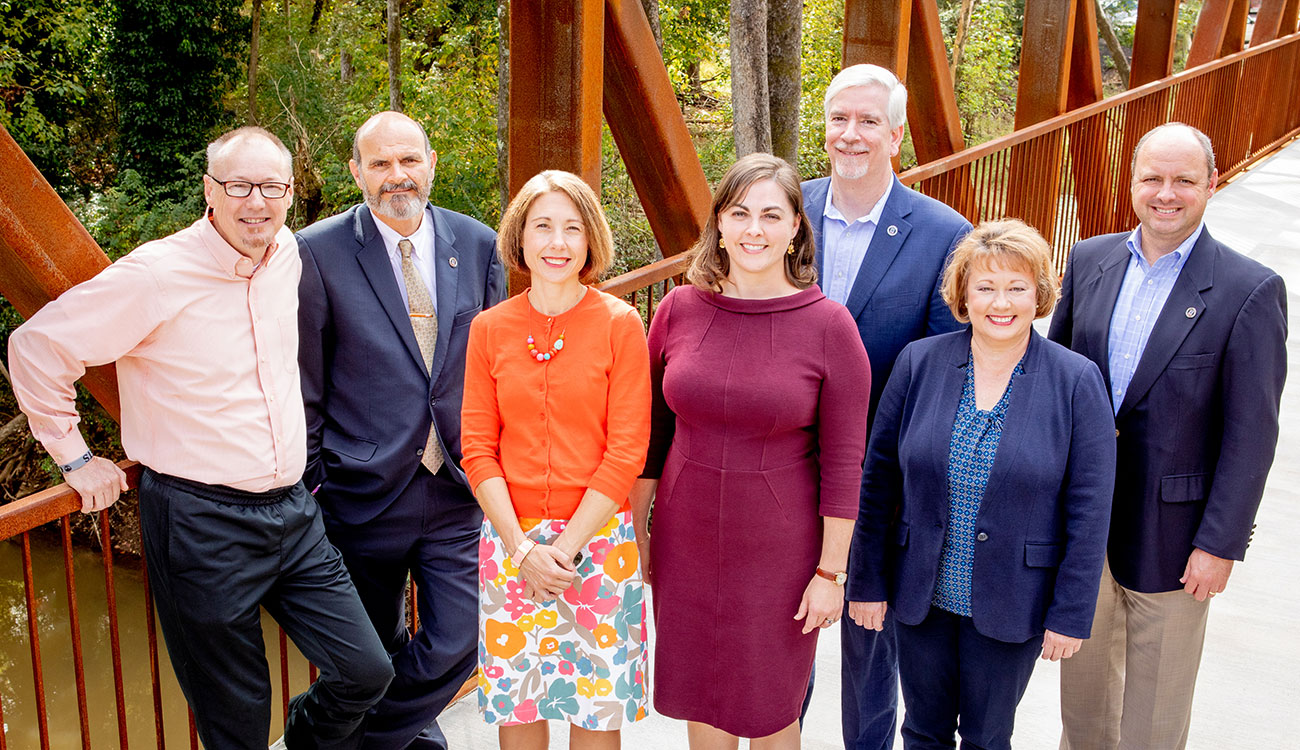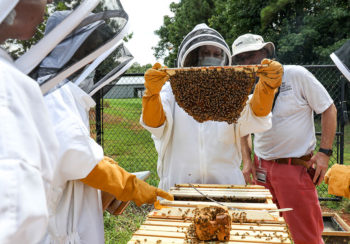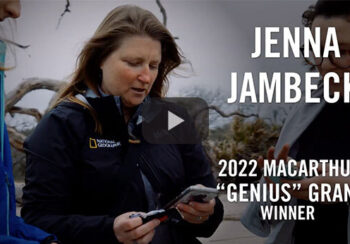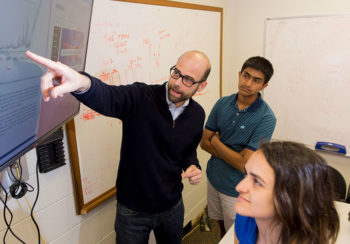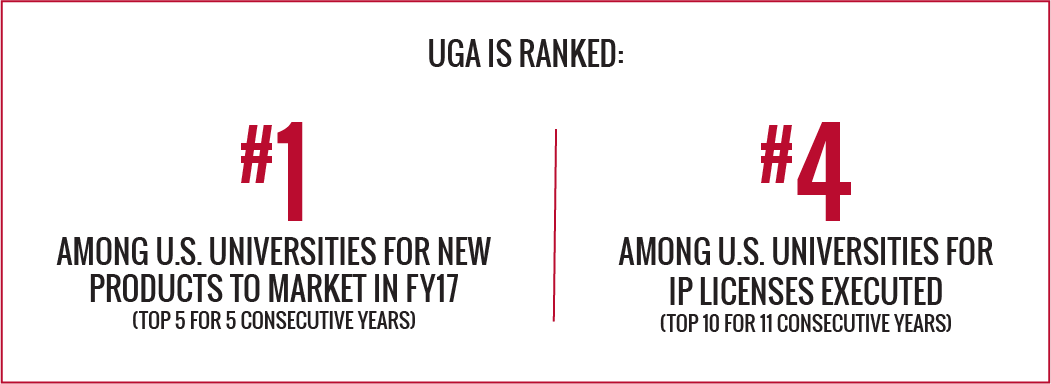
This cycle of IP licensing and commercialization has been going strong at UGA for four decades, longer than all but a few university peers, and it is central to the university’s Innovation District initiative. Yet even as these activities have taken off not just at UGA but around the country, “technology transfer” and commercialization are not universally understood terms in academe. Even the faculty who participate often are not familiar with their complexity.
Luckily, UGA is a great place to learn. To date, nearly 800 products have been developed out of university research, ranging from plant cultivars to software packages, research tools to health diagnostics and therapeutics, and many other product types aimed both at general and specialized consumers.
Lately the pace has really picked up: According to the Association of University Technology Managers (AUTM), for 14 consecutive years UGA has ranked among the country’s Top 10 universities in number of licenses and options executed. In fiscal 2019 alone, UGA executed 182 licenses and options, bringing in $11 million in overall licensing revenue—a 70 percent increase since 2015.
“Licensing, technology transfer, commercialization—they’re all centered around a pretty basic principle,” said Derek Eberhart, associate vice president for research and executive director of Innovation Gateway, UGA’s tech transfer operation. “The idea is: How do we take a technology and move it forward to market for public benefit? That’s the land-grant mission that we play a role in. How do we move those resources out of the university?”
The newly redesigned Jack Nicklaus Great Waters course at Reynolds Lake Oconee uses two types of UGA-developed turfgrass to carpet its lush landscapes: TifTuf® on the course roughs and TifEagle on the greens. “Having so many golf holes, we get to see a lot of turfgrasses before they ever hit the market and even before they develop a name for them,” said Lane Singleton, vice president of agronomy for Reynolds Lake Oconee. “We work very closely with the university to enhance what we do from a technology standpoint and stay on the cutting edge.” (Image courtesy of Reynolds Lake Oconee)
Tech transfer: A brief history
That idea, of squeezing more public value out of higher education funding, is what sparked the tech transfer boom nearly 40 years ago. Until 1980, nearly all IP developed with federal funding support belonged to the federal government, and neither universities nor individual investigators had the legal right to commercialize such discoveries. Then two U.S. senators—Democrat Birch Bayh of Indiana and Republican Bob Dole of Kansas—co-sponsored what became the landmark Bayh-Dole Act of 1980, which in most cases allowed universities to retain ownership of federally supported IP.
“In one fell swoop, you went from UGA having virtually no impact in commercializing their inventions, to now they’re actually responsible for commercializing their inventions, resulting in revenue that can be reinvested in future research and innovations,” said Steven Susalka, CEO of AUTM, a global nonprofit whose members work to support and advance government-funded academic research innovations.
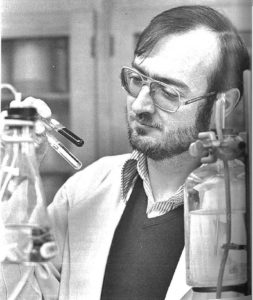
UGA formed the UGA Research Foundation two years before Bayh-Dole in part to facilitate commercialization of university IP. Originally handled within the Office of Research, tech transfer activity grew, and over time UGA created such units as the Technology Commercialization Office and the Georgia Bio Business Center to manage it. In 2015 UGA created Innovation Gateway to bring all commercialization activities under one roof.
“Technologies developed at UGA have the potential to boost economic activities and also improve the quality of life for people in Georgia and well beyond,” said David Lee, vice president for research. “We have made it a major priority to help faculty move technologies out of the lab and into the marketplace, where they can be put to broad use. The data indicate that our efforts have paid off.”
Nearly four decades after Bayh-Dole, Susalka said, even modest-sized research universities now have their own tech transfer offices, and AUTM estimates the “total contribution of academic licensors to industry gross output” could reach as high as $1.7 trillion for the 22-year period (1996-2017) for which it has collected data. The organization’s Better World Project seeks to promote public understanding of the role university technology commercialization plays in people’s everyday lives around the world.
The Association of University Technology Managers created this video to explain the process of licensing university research for commercial use, also known as technology transfer. “Tech transfer allows for the culmination of decades of research, for it to actually turn into societal benefit,” said AUTM CEO Stephen Susalka. “People talk about revenue—that’s the icing on the cake. That’s not why you do it. You do it for the societal benefit.” (Video courtesy of AUTM)
“It is critical, an absolutely essential role in the development of new products and services,” Susalka said. “You have a whole suite of remarkable inventions that have been commercialized out of university research.”
UGA’s success in licensing predates most of its peers’. By the late 1970s, when UGA graduate student Marion Bradford was creating his Bradford Protein Assay that would become one of the world’s most widely used research tools, the university had been a national leader in plant cultivar development for decades. UGA’s Cultivar Development Research Program has been critical in taking a portion of plant-licensing revenue and pouring it back into the research enterprise.
The university has also built a core strength in life science innovation. Some of UGA’s major product successes include Restasis for treating dry eye, Clevudine for hepatitis B and Kanuma for a rare metabolic disease called LAL-D, not to mention many vaccines for the agricultural industry, especially poultry producers.
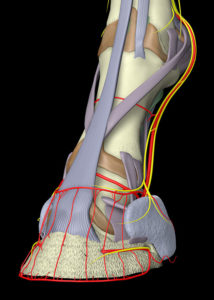
Other notable products include educational software packages like Glass Horse (for exploring equine anatomy) and SABLE (Skills and Assessments-Based Learning Environment, which allows teachers to personalize instruction in real time), agricultural technologies like electrostatic spraying technology, and research tools akin to the Bradford assay. In recent years, the pace of such inventions has really picked up.
“When I came to UGA in 2008, we’d had less than 2,000 invention disclosures in the 30 years since UGARF was formed,” Eberhart said. “Now we’re tracking about 200 per year. Part of that is just the growth in the research enterprise—we’ve got a lot more dollars flowing in and enabling more research activity, than in earlier days when UGA was still growing into a premier research institution.”
Vaccines, pharmaceuticals and other biotech innovations accounted for nearly a third of UGA’s licensing revenue in fiscal year 2019. The university is particularly strong in developing vaccines for the poultry industry, one of Georgia’s largest economic sectors. Selected examples include: Fowl Cholera poultry vaccine, PM-ONEVAX©, poultry coccidial vaccine, HatchPak® Cocci III, and Mycoplasma gallisepticum vaccine, recently launched in Japan, with more countries pending.
Licensing 101
Even as tech transfer has picked up, many faculty researchers are still unfamiliar with how the process works, and for very understandable reasons.
“That’s not what they’ve been trained to do,” said Cory Acuff, associate director of Innovation Gateway, which has a handy guide to commercialization on its website. “Licensing of technology or submitting invention disclosures—that’s typically not part of a doctoral program.”
For all its permutations, tech transfer essentially boils down to two things: protecting the IP and sharing the IP. Investigators submit an invention disclosure—still the first step in all commercialization activities—and UGA determines whether to protect the idea through a patent application. If it does, the university then tries to broker licensing agreements with outside companies to turn the patented idea into a product.

Of course, within those two broad steps are a lot of twists and turns. There are publishing considerations for any IP a researcher is looking to commercialize. There are potential conflicts of interest to manage. And a bona fide licensing agreement is often the final product of conversation between university and industry that began long—sometimes years—before. The license commonly is preceded by multiple enabling steps like material transfer or confidential disclosure agreements, which allow both researchers and companies to test the waters and share protected information.
Like many other businesses, tech transfer can be as much about who you know as what you know.
“We’re in the relationship business,” Acuff said. “I’m not in the licensing business—that’s just an outcome of the relationship. The first thing we’re always doing is asking these companies, ‘What do you want? What are you looking for?’ We want to help our faculty members expand their relationship base. That leads to new friends, that leads to sponsored research, that leads to all these networking opportunities, which are just as valuable to our faculty as the licensing revenue stream that we might or might not get.”
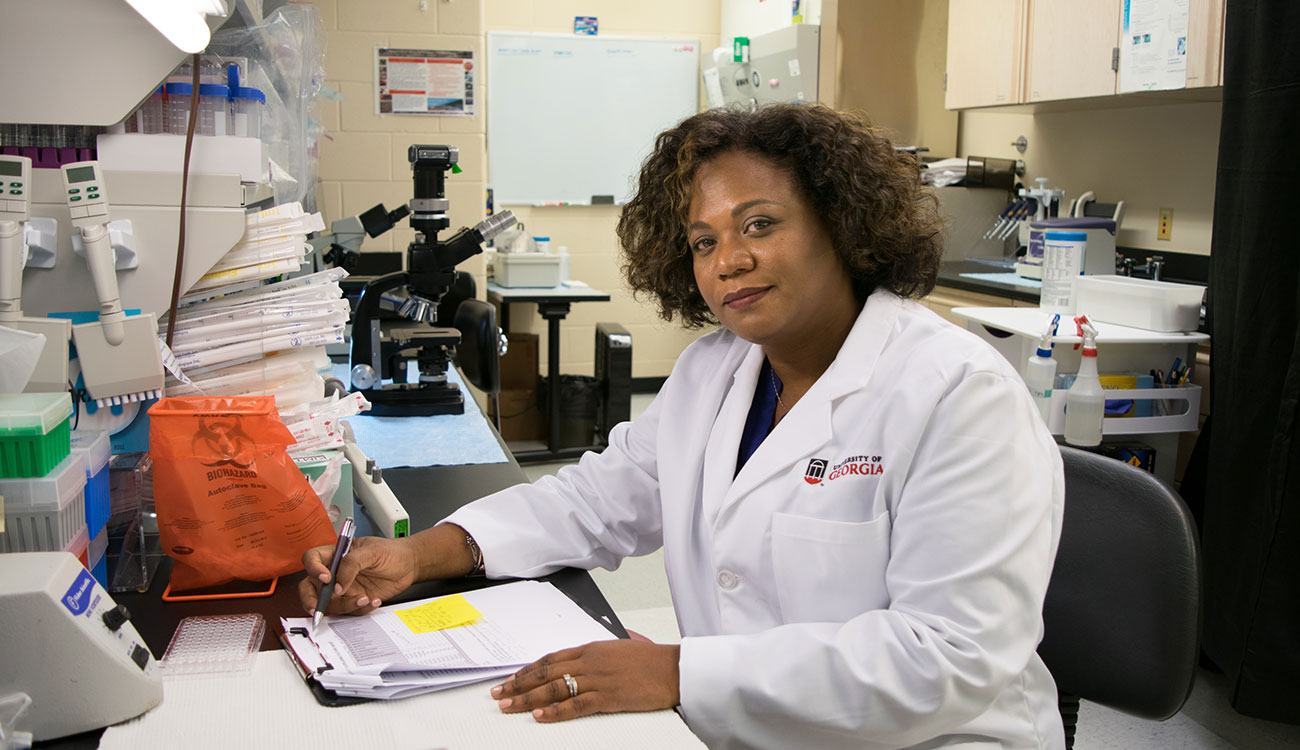
Because it’s been doing tech transfer for so long, UGA has a list of companies that know the university well and have been doing business with its faculty for years. Likewise the Innovation Gateway staff have their own internal faculty “clients” and put in the face time necessary to get to know them better, as well as meet new faculty in their specialty areas.
“I go to a lot of internal retreats,” said Shelley Fincher, Gateway’s licensing manager who specializes in plant cultivars. “That’s a good way for me to talk casually with new faculty, along with their graduate students. You just have to keep getting yourself out there in front of them.”
“People know what I’m working on—they know I work with vaccines,” said Naola Ferguson-Noel, associate professor in the College of Veterinary Medicine, whose research in poultry vaccines has resulted in multiple license agreements. “Usually I’ll have some familiarity with a company, how they operate, how large they are, and we’ll go from there.”
Finally, there are differences—often big ones—in the licensing process depending on the investigator’s research field, especially in the time required. A piece of software may be ready for commercial sale from the moment the ink is dry on the licensing agreement, while pharmaceuticals intended for humans can take many years, even decades, to make their way through the testing and trials required for FDA approval. And that’s not even counting the time required to secure the initial patent.
“A typical biologic type of invention, a vaccine or a therapeutic, can take 10, 15 years or longer until a product actually reaches the marketplace—that can be half of someone’s career in biomedical research,” Acuff said. “That’s the first big shocker we run into while educating our faculty. You can’t just submit an idea or scientific discovery and expect a product on the market within a year or two.”
“I was really surprised by the amount of time it takes to get a patent awarded,” said Jason Locklin, professor in the College of Engineering and director of the New Materials Institute. “I’ve got a lot of experience now with patenting ideas and technologies, and it still perplexes me, the length of time it takes to get technologies through the U.S. patent system.”
Toward an Innovation District
That issue—the time and effort needed to turn good ideas into products—has led to a third major component to university tech transfer: startup support. Those resource requirements for product development apply not just to higher education but also to industry, and increasingly companies are outsourcing the task to universities.
Sometimes it happens through sponsored research agreements, but more and more often, investigators are taking the entrepreneurial risk and licensing their own IP from the university to form startup companies and shepherd their ideas across the “valley of death” between laboratory success and commercial-scale production. Typically the goal is not to see the startup company through all the way to the Fortune 500, but rather to grow it just to the point where it can prove an underlying technology is commercially viable, before being gobbled up by a larger company (what’s known in the parlance as an “exit event”).
“There’s a big drug company that renamed its research and development department to ‘acquisition and development,’” Susalka said. “What does that tell you? It tells you that companies are getting away from early-stage research, and universities are filling that void. Industry is moving further down the development pipeline. They’re looking for things that are less risky.”
Susalka said the number of university startups nationwide has effectively doubled over the past 10 years, and UGA is ahead of the curve. For the past two fiscal years, Innovation Gateway has supported more than 100 startups in its incubator pipeline, more than twice the number it had as recently as 2015. The university landed an NSF I-Corps grant in 2017 to provide training and funding support for its startups, and the program will have a new physical home once the renovated Spring Street Building opens in early 2021.
“Our startups can take early-stage technologies, clinical candidates, and do some of the risk-reducing work to get the technology to a space where a large pharma or biotech company is interested,” Acuff said.
“UGA was willing to be a global citizen. They said, ‘If you can take this to the next level, go ahead. We’re willing to help you help the rest of the world.’ I think that’s unique. A lot of times inventors struggle with their university with an issue like this, because the university is simply looking at the profit motivation.”
– William Kisaalita, professor, College of Engineering
Startups also provide another avenue when a technology is more humanitarian in nature. For example, Professor William Kisaalita in the College of Engineering developed a milk cooler powered by bio-gas that can help rural dairy farmers in Africa better preserve the milk that is their livelihood. Because of its target market, Kisaalita had trouble finding companies to license the technology, so he founded his own company (Thermogenn) to manufacture the coolers, in hopes that a government, foundation or non-governmental organization will purchase them in bulk. UGA provided the technology license to Kisaalita free of charge.
“UGA was willing to be a global citizen,” Kisaalita said. “They said, ‘If you can take this to the next level, go ahead. We’re willing to help you help the rest of the world.’ I think that’s unique. A lot of times inventors struggle with their university with an issue like this, because the university is simply looking at the profit motivation.”
In the end, technology licensing and startup formation are simply two colors in a kaleidoscope of innovation at UGA that cuts across all disciplines and research areas, across a diversity of faculty and student entrepreneurs, and across the full palette of talents, ambitions and motivations behind it all. When UGA announced its Innovation District initiative last year, the idea was not to drive the creation of something new, but rather to add structure, support and guidance to something that was already thriving.
“Since that announcement, there’s definitely a broadening of interest and people working with us from different areas of the university where we haven’t always had activity,” Eberhart said. “That’s one of the goals: to make sure we’re tapping into every college, making them aware and offering the services of tech transfer to every unit within UGA.”



